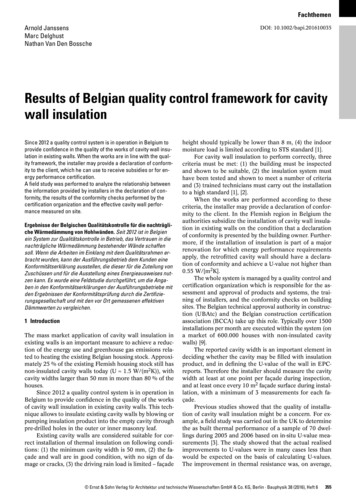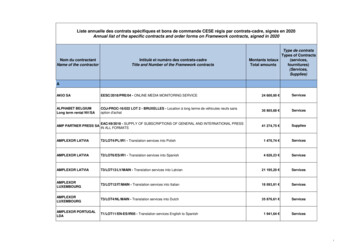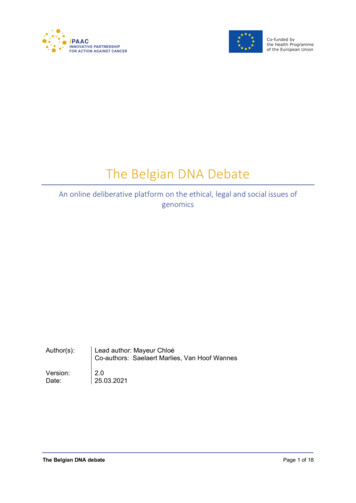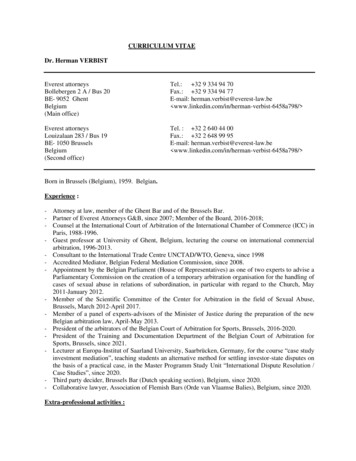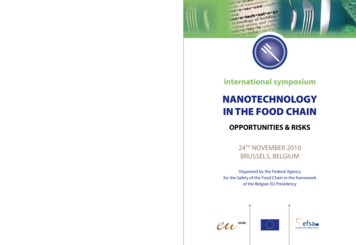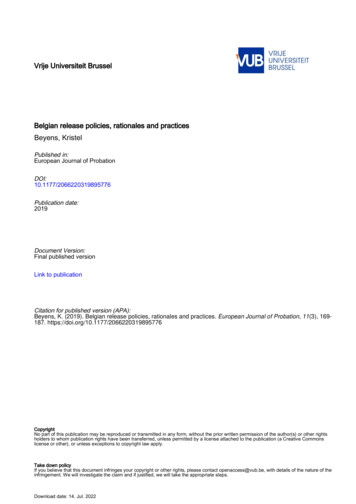
Transcription
Vrije Universiteit BrusselBelgian release policies, rationales and practicesBeyens, KristelPublished in:European Journal of ProbationDOI:10.1177/2066220319895776Publication date:2019Document Version:Final published versionLink to publicationCitation for published version (APA):Beyens, K. (2019). Belgian release policies, rationales and practices. European Journal of Probation, 11(3), 169187. o part of this publication may be reproduced or transmitted in any form, without the prior written permission of the author(s) or other rightsholders to whom publication rights have been transferred, unless permitted by a license attached to the publication (a Creative Commonslicense or other), or unless exceptions to copyright law apply.Take down policyIf you believe that this document infringes your copyright or other rights, please contact openaccess@vub.be, with details of the nature of theinfringement. We will investigate the claim and if justified, we will take the appropriate steps.Download date: 14. Jul. 2022
8957762019EJP0010.1177/2066220319895776European Journal of ProbationBeyensOriginal ArticleBelgian release policies,rationales and practicesEuropean Journal of Probation2019, Vol. 11(3) 169 –187 The Author(s) 2019Article reuse /doi.org/10.1177/2066220319895776DOI: ejpKristel BeyensVrije Universiteit Brussel, BelgiumAbstractBelgium has a two-track policy towards prison release: a quasiautomatic administrativerelease system for those with a prison sentence of up to three years, and a discretionarysystem operated by multidisciplinary Sentence Implementation Courts for persons witha prison term of more than three years. This article describes, discusses and comparesboth release systems, with a particular focus on their rationales and consequences andprovides updated figures on the use of the different forms of release in Belgium. Theprinciple of relative autonomy will be described as an important legitimation strategy ofconditional release. The article explains how the sentence implementation rationale ofreintegration is put forward as an important aim of sentence implementation in the lawand how it is pursued in practice. The consequences of the increasing use of the ‘gradualsystem’ of release on the detention trajectory of long-term prisoners will be illustrated.KeywordsBelgium, maxing out, release, two-track systemIntroductionWith the introduction of the so-called Act Lejeune in 1888, Belgium became one of thefirst countries in Europe to introduce conditional release (voorwaardelijke invrijheidstelling or liberation conditionelle), in order to allow some individualisation during the execution of punishment. An administrative discretionary system was installed and for 100years parole was granted following an administrative but non-transparent procedure,where the Minister, or the members of the cabinet, could reject or accept requests forrelease, without having to provide a justification or judicial guarantees. This gave ministers a lot of power within the penal sphere and raised multiple criticisms, not least fromprisoners. This decision-making power also came at a political cost, particularly inCorresponding author:Kristel Beyens, Department of Criminology, Vrije Universiteit Brussel, Research Group Crime & Society,Pleinlaan 2, Brussels, 1050, Belgium.Email: Kristel.Beyens@vub.be
170European Journal of Probation 11(3)instances where a parolee committed further high-profile offences. The infamous Dutrouxcase in 1996, which involved the abduction, rape and murder of several young girls whileDutroux was on parole, and whose conditional release was decided by the then Ministerof Justice Wathelet, was therefore a catalyst to hand over the decision-making responsibility for conditional release to multidisciplinary ‘Parole Commissions’ in 1998 and finallyto independent multi-disciplinary Sentence Implementation Courts in 2006.The Act of 2006 on the External Legal Position of Convicted Prisoners and the Rightsof the Victims in the Framework of Modalities of the Implementation of Sentences (hereafter the Act of 2006 on the External Legal Position) transferred the decision-making authority from the executive to the judiciary in order to reinforce procedural and substantivestatutory rights of prisoners (e.g. due process, fairness, legitimacy) and to address the criticism regarding the lack of judicial guarantees in the release procedure in Belgium. Themulti-disciplinary composition of the Sentence Implementation Court was regarded as anecessary condition to improve the quality of the decision-making regarding release, whichrequired a combination of legal reasoning and expertise in social reintegration and theeffects of the deprivation of liberty (Scheirs et al., 2015; Snacken et al., 2010). SentenceImplementation Courts are presided over by a professional judge with a minimum of fiveyears’ judicial experience who has been trained for appointment to the SentenceImplementation Court. The two assessors are not professional judges, nor are they equivalent to lay-magistrates, as they are full-time professionals actively serving as a member ofthe court with a university degree (e.g. criminology, psychology, sociology, law) and aminimal professional expertise of five years in matters of social reintegration or prison.Current assessors have professional expertise as prison governors, as members of the psychosocial service in prison or as justice-assistants (probation officer) (Scheirs, 2016: 86).As all the provisions on release were described in numerous and non-publicly available Ministerial Letters, an important goal of the Act of 2006 on the External LegalPosition was to streamline the procedure for all convicted prisoners and to bring all thescattered provisions together in one Act. However, since 1 February 2007 and still at thetime of writing (Autumn 2019), the Sentence Implementation Courts make decisionsregarding the detention trajectory of persons sentenced to more than three years imprisonment. The transfer of the decision-making for persons with a shorter prison sentencehas been postponed several times and thus still remains an administrative responsibility,leaving the authority of decision-making with the Prison Administration (in the majorityof cases the prison governor). However, on 25 April 2019, a Bill has been accepted bythe Chamber of Representatives that announces the entry into force of the part of the Actfor this group of prisoners by 1 October 2020 the latest. This division reflects an important characteristic of the Belgian release system, namely, its two-track (or bifurcated)system, with different procedures for persons sentenced to a maximum prison term totalling three years (so-called ‘short-term prisoners’) than for those with prison sentences ofmore than three years (so-called ‘long-term prisoners’). In practice, this means that themajority of convicted prisoners are released under a quasi-automatic and fast administrative procedure, while in contrast a smaller group of long-term prisoners are made subjectto a very complex release procedure with several checks and balances.The aim of this article is to briefly describe1, discuss and compare both release systems2,with a particular focus on their rationales and consequences. I will also provide updated
Beyens171figures on the use of the different forms of release in Belgium. The article starts from theidea that Belgian release has to be understood within the wider context of sentencing andpenitentiary policies and practices. The principle of relative autonomy between the aims ofsentencing and sentence implementation will be explained as an important legitimationstrategy of conditional release in Belgium. The article further explains how the sentenceimplementation rationale of reintegration has been mobilised in the law, how it is operationalised in practice and discusses its consequences in relation to the detention trajectoryof long-term prisoners. This is linked to the rising number of prisoners maxing out their fullsentence, in prison or under electronic monitoring.A revolving-door quasi-automatic release system for ‘shortterm’ prisonersAccording to the Act of 2006, a single Sentence Implementation Judge should decideupon the provisional release (‘voorlopige invrijheidstelling’ or ‘libération provisoire’) ofpersons with a prison term of to up to three years. However, the transfer of this decisionmaking competence from the Prison Administration to the Sentence ImplementationJudge has not yet been realised. So, today, the biggest group of convicted prisoners is stillreleased following an automatic administrative procedure, that is described and regularlyadapted in several Ministerial Circular letters, that are not public and thus do not allowparliamentary scrutiny as ordinary legislation would entail. The regulation of sentenceimplementation through unpublished Letters and Circulars is, however, an often-appliedpolicy in Belgium, allowing Ministers to promptly react to changing circumstances(prison overcrowding, for example), and thus to avoid lengthy legislative procedures.Initially, provisional release started as an administrative measure by the PrisonAdministration, because parole had always been hampered for short-term prisoners dueto the length and complexity of the procedure. Consequently, in 1972 an ‘alternative’early release for prisoners serving sentences of up to one year was introduced and called‘provisional release in view of pardon’. It was originally an individual decision leadingto an individual pardon for each prisoner. Pressured by the increasing prison overcrowding, from 1983 onwards the Prison Administration applied this tool more systematicallyand collectively, releasing all prisoners sentenced to up to one year after having served apart of their sentence. These releases were also renamed ‘provisional release for reasonof overcrowding’ (Snacken et al., 2010). In 1994, this form of release without specificprocedural safeguards became extended to sentences of up to three years imprisonment.With 77% of all the releases of convicted prisoners in 2017 (see Table 1 below), theyhave remained the major form of early release in Belgium. This means that, in the majority of the cases, local prison governors have the authority to decide about release. Incertain ‘sensitive’ cases, however, such as sexual offences with minors and offences ofhuman trafficking and terrorism, the decision-making authority is transferred to theDirection Detention Management at the Central Prison Administration. The conditionsfor eligibility with regard to sentence length have changed over time and are very complex, but the general rule was that all prisoners, irrespective of whether they are firstoffenders or recidivists, were automatically provisionally released after having served atmost one-third of their sentence, in custody or under electronic monitoring (see later).
rovisional releaseof persons with aprison sentence ofup to three ovisional release offoreigners with morethan three years prisonsentence(decision of SentenceImplementation Court)5.8%7397.7%4679.4%272Conditional releaseof persons with aprison sentence ofmore than three years(decision of SentenceImplementation Court)5.5%2602.7%0.0%260Foreigners awaitingexpulsion inadministrativedetention centresafter their ource: Personal communication with the Prison Service, July 2019. The data are recalculated by the author.1Mentally ill prisoners are not included in the table, as legally they are not convicted to a prison sentence, but to a security measure, so-called internment, which isdealt with by a separate chamber of the Sentence Implementation Courts. Internment is a measure that is undetermined in time.TotalPercentagesAfterprisonAfter EMEnd ofsentence(maxing out)Table 1. Release of persons convicted to a prison sentence1 according to the different modalities: 2017.172European Journal of Probation 11(3)
Beyens173Since 16 May 2017, Ministerial ‘Temporary Instructions’ have been issued, with newand even shorter eligibility periods of release : persons with a prison sentence of up tofour months are immediately released; persons with a prison sentence between four andsix months are immediately released or after one month if they are convicted after 31January 2014; persons with a prison sentence between six and seven months are releasedafter one month; with a prison sentence between seven months and one year after twomonths; with a prison sentence between one and two years after four months; and persons with a prison sentence between two and three years are released after having servedeight months in prison or under electronic monitoring.This release system through internal regulations is very flexible, but also unstable andcan thus entail insecurity for the prisoners. The automatic nature of release for prisonersserving ‘short’ sentences means that there is no requirement for the views of the prisoners or any victims of an offence to be heard on the matter. Nor is there any possibility toappeal the decision to a higher decision-making authority. In this procedure, the prisoneris barely prepared for release and post-release supervisory conditions are only rarelyimposed, so aftercare or supervision after detention are not generally implemented.Since the Belgian prison system has suffered from overcrowding since the mid-1980s(Beyens et al., 1993), it is clear that this policy has been used by consecutive Ministersof Justice as a form of ‘back-door’ mechanism (Rutherford, 1984) to relieve the pressureon the prison population. It is perhaps not surprising that for prison governors, who haveto deal with the consequences of prison overcrowding on a daily basis, this form ofrelease is welcomed and has become fully integrated in their daily practices. While primarily a pragmatic policy, provisional release can therefore also be regarded as beingpart of an inadvertent reductionist policy to avoid an expensive and lengthy process ofexpansion of prison capacity. However, a genuine reductionist policy, would mobilisemore front-door measures and promote alternatives to custody such as community sentences, to keep offenders out of prison as long as possible and to avoid the harms ofdetention. Providing for real alternatives to custody is a complex and lengthy process. Itis known for instance that introducing non-custodial alternatives through legislation doesnot guarantee their implementation by the judiciary. It is also evident that there is apotential for unintended net-widening and mesh-thinning effects, whereby non-custodial‘alternatives’ replace other non-custodial sentences (such as fines) rather than displacingthe use of prison sentences (Cohen, 1985).In this light, automatic release of ‘short-term’ prisoners can be seen as a quick-fixsolution to pressing penitentiary problems while at the same time presenting a lever forgovernment ministers when faced with pressure to reduce prison overcrowding. InBelgium, this pressure manifests as part of the daily penitentiary landscape in the formof protests and strikes by prison officers who complain about the detrimental consequences of overcrowding on their working conditions (Beyens, 2019). Reducing theprison population by facilitating release remains an easy option for the government andthe delay or resistance to full implementation of the Act of 2006 on the External LegalPosition must therefore be seen in this light. A further relevant factor has been a concernto control the workload of the Sentence Implementation Courts. In 2017, for example,77% or 7423 decisions were related to cases of up to three years of imprisonment (seeTable 1 below).
174European Journal of Probation 11(3)A further complicating factor in this overall picture is that since 2000, another ‘solution’ for prison overcrowding was introduced in Belgium, namely, the replacement ofprison sentences by electronic monitoring. Initially the introduction of electronic monitoring was justified as a tool for supporting re-integration and harm reduction, however,it is evident that it quickly became another systemic management tool in the fight againstprison overcrowding. As with the differential frameworks for prison release based onsentence length described above, different decision-making mechanisms also apply forelectronic monitoring based on the length of the prison sentence imposed. Depending onthe offence, prison sentences of up to three years can be fully or partly converted intoelectronic monitoring by the prison governor or the Central Prison Administration(Direction Detention Management).3 This means that the part of the prison sentence thathas to be served up to provisional release, can be served in prison or at home under electronic monitoring. Here too we have seen the relaxing of eligibility conditions for electronic monitoring over time and for the same reasons as for provisional release – namelysystemic pressure. The replacement of prison sentences with electronic monitoring alsooccurs quasi-automatically, and here too the prison governor and the Direction DetentionManagement have the decision-making authority. Those made subject to electronic monitoring in these circumstances serve their sentence in the community, where they arerequired to adhere to a time schedule (i.e. they have specific curfew hours), but they doso without supervision by a justice assistant.4This has led to a situation where electronic monitoring has become a cheap way ofexecuting prison sentences and its standardised application allows more convicted persons to be processed through the penal system at a lower cost thereby facilitating a revolving-door policy (Beyens and Roosen, 2017). However, such policies have raised questionsregarding the credibility of the execution of sentences system in Belgium, particularlywith the judiciary, but also with the wider public and thus also with politicians who aresensitive to criticisms that the system operates with impunity. Before discussing this issueof legitimacy in more detail, the following section of the article will explain the releasesystem of those convicted to a prison sentence of more than three years.A complex discretionary release procedure for ‘long-term’prisonersOne of the most important innovations since the introduction of conditional release in1888 was the transfer of the authority to release prisoners before the end of their sentencefrom the executive power to independent Multidisciplinary Commissions in 1998 and tomulti-disciplinary Sentence Implementation Courts in 2006. Since February 2007, thesemulti-disciplinary courts decide on the detention trajectory of prisoners sentenced tomore than three years of imprisonment, after a judicial procedure and an adversarialcourt hearing where the Public Prosecutor, the prison governor and the prisoner and/oreventually his or her lawyer are heard. All the decisions have to be carefully articulatedin a written verdict. For the legislator, this multi-disciplinary composition was seen as aguarantee for expert and deliberate decision-making through which the parliament aimedto improve the quality of the decision-making and to enhance the courts’ independenceand professionalism (see also Scheirs et al., 2015).
Beyens175To be eligible to apply for conditional release, a minimum period of detention mustbe served, namely one-third for first offenders and two-thirds for repeat offenders(‘legal recidivists’). According to the Act of 2006 on the External Legal Position, prisoners sentenced to life imprisonment have to have served at least 10 years of detention,repeat offenders have to have served at least 16 years of their sentence before they areconsidered eligible to apply for release. So repeat offenders are subjected to a moresevere release system, and are doubly punished, as repeat offending is also an aggravating element in the sentencing phase. In March 2013, the time conditions have beenrestricted for prisoners sentenced to 30 years imprisonment or life sentences5, after thehighly publicised release of Michèle Martin, Dutroux’s wife, who had assisted in hiscrimes. Since then, persons sentenced to 30 years or life-imprisonment have to serve atleast 15 years of their prison sentence, which increases their eligibility date from onethird to at least half of the sentence, legal recidivists have to have served at least 19 or23 years of detention, depending on their earlier convictions. The time conditions forprisoners with a prison sentence of up to 30 years have remained the same. To preparefor reintegration, temporary prison leave (uitgaansvergunning, maximum 16 hours) andprison furlough (penitentiar verlof, maximum 36 hours) can be granted by the Ministerof Justice (in practice the Direction Detention Management at the Central PrisonAdministration) two years before the eligibility date for conditional release. ‘Sentenceimplementation modalities’, such as semi-detention6 and electronic monitoring aremore controlling measures, allowing a ‘safer’ transition from prison to society, thanconditional release. Therefore, they can only be granted six months before the eligibilitydate of conditional release. All these intermediate measures are thus also delayed for theprisoners with a prison sentence of 30 years up to life imprisonment. The time conditions are strictly formulated by law and leave no discretionary room to the SentenceImplementation Courts to deviate; in other words, if the time conditions are not fulfilled, the prisoner cannot be released.Further, the Act of 2006 on the External legal Position of the Prisoners states that aconditional release order is awarded if the time-conditions are fulfilled and if there areno counter-indications for release. The Sentence Implementation Courts are thereforerequired to assess five additional counter-indications, that might endanger a smooth reentry into society, namely: (1) the absence of the prospects of the social reintegration ofthe offender; (2) the risk of committing new serious offences; (3) the risk that the offenderwould harass the victims; (4) the attitude of the offender towards the victim(s) of theoffence that has led to the conviction and (5) the absence of efforts of the prisoner tofinancially compensate the victims. It has to be pointed out that three of the counterindications are victim-related and that the attention for the victims in the parole procedure is also reflected in the name of the Act of 2006, which explicitly mentions theinterests of the victims.7 To counter any such risks prisoners have to prepare a reintegration plan that describes the efforts they have already made to prevent these risks upontheir release and how they will be dealt with after their prison stay. Three main anchorpoints guide the Sentence Implementation Court’s evaluation of the reintegration plan:(1) where the prisoner will reside on release; (2) how they will be occupied (work or anyother day activity) and (3) whether they will be required to undergo treatment, e.g. drugtreatment (Scheirs 2014, 2016).
176European Journal of Probation 11(3)As the Act stipulates that conditional release ‘is granted’ if the time and other conditions are fulfilled, some scholars interpret this as a legally constructed ‘subjective right’for the prisoner (Pieters, 2009; Snacken, 2004). However, as the counter-indications arepotentially very wide-ranging, the Sentence Implementation Courts have a broad scopefor discretion, meaning that this system still can be described as a discretionary releasesystem (Scheirs, 2014; Snacken et al., 2010). Indeed, the evidence supports this characterisation. As a result of this assessment procedure and the difficulties in meeting theprescribed conditions, the majority of prisoners do not leave prison after one-third, halfor even two-thirds of their sentence, but mainly stay in prison for considerably longerperiods (Maes and Tange, 2014). Furthermore, when a person is released, they arerequired to adhere to general and individual conditions. The general conditions are stipulated by law and entail that the released person should not commit new offences8 duringhis licence period, is required to have a home address, and has to respond to any questions and appointments with the justice assistant or Public Prosecutor. Typical individualconditions include an obligation to maintain meaningful daily activity and/or to follow atreatment plan, and prohibitions on drinking alcohol, on using drugs or possessing gunsand/or on contacting the victim(s) of the offences that have led to the conviction (Scheirs,2014, 2016).Data on prison releaseAs mentioned previously, the majority of the convicted prisoners are released via a quasiautomated system. Table 1 provides an overview of the number of releases of convictedprisoners, distributed over the different modalities in 2017.Table 1 shows that more than three-quarters (76.9%) of all the releases of convictedprisoners occur through the quasi-automatic administrative system, while the SentenceImplementation Courts only decide on approximately 12% of all the releases (total of4.3% and 7.7%, i.e. all sentences of more than three years). However, in practice, theSentence Implementation Courts are also responsible for the ‘end of sentence’ group, asthese are all prisoners who have either applied unsuccessfully for a release modality(electronic monitoring, semi-detention or conditional release), did not undertake anyrelease action at all or who maxed out their sentence under electronic monitoring (15.1%of all those who served until the end of their sentence, see Table 2). This phenomenon ofthe rising number of prisoners who max out their full sentence will be further discussedin the following section.Table 2 illustrates the (growing) importance of electronic monitoring as a form ofsentence implementation: 63.2% of all the prisoners with a prison sentence of more thanthree years are conditionally released after electronic monitoring, which illustrates theincreasing importance of electronic monitoring as a transitionary phase between prisonand conditional release (cf. ‘progressive’ system). Although, following the MinisterialCirculars, sentences of up to three years are quasi-automatically converted into electronic monitoring, the data show that still a considerable part of this group (41.4%) isreleased from prison. This high number of people still serving their sentence of up tothree years in prison can have several reasons, such as: people serving the part of theirsentence up to provisional release in prison under remand and when finally convicted
15.1%84.9%100.0%58.6%41.4%100.0%Provisional releaseof persons with aprison sentence ofup to three ional release offoreigners with morethan three years prisonsentence(decision of SentenceImplementation Court)63.2%36.8%100.0%Conditional releaseof persons with aprison sentence ofmore than three years(decision of SentenceImplementation Court)Source: Personal communication with the Prison Service, July 2019. The data are recalculated by the author.After EMAfter prisonTOTALEnd ofsentence0.0%100.0%100.0%Foreigners awaitingexpulsion inadministrativedetention centresafter their prisonsentenceTable 2. Release of persons convicted to a prison sentence according to whether it is from prison or from electronic monitoring: 2017.51.2%48.8%100.0%TOTALBeyens177
178European Journal of Probation 11(3)being immediately released from prison; prisoners who are convicted for terrorist relatedoffences, human trafficking and sexual offences with minors are excluded from electronic monitoring, persons under electronic monitoring who are recalled to prison, prisoners who do not have a fixed address or residence or who are illegal in the country arenot granted electronic monitoring; people who refuse electronic monitoring and ‘prefer’to serve their sentence in prison.DiscussionThis section deals with the main issues of the debate on prison release in Belgium,namely the principle of the relative autonomy of the aims of sentencing and the execution of sentences, the aim of reintegration and how this is pursued in practice and therising phenomenon of maxing out.Relative autonomy of the aims of sentencing and the execution ofsentences as an important leading principle of paroleWhy is parole needed and where can its legitimations be found? The Belgian Prison Actof 2005 that enacts prisoner’s rights and the Act of 2006 on the External Legal Position,that enacts the release modalities, are both rooted in the principle of the relative autonomy of the aims of the implementation of sentences and of the aims of sentencing. Thisprinciple reflects and justifies the different priorities in decision-making at the differentstages of punishment and states that whatever the aims may have been at the time ofsentencing (retribution, general prevention, incapacitation etc.), these cannot be considered automatically to determine the content of the execution of the imprisonment(Dupont, 1998: 135; Snacken, 2004; Snacken et al., 2010; van Zyl Smit and Snacken,2009). Both laws that regulate the implementation of prison sentences state that imprisonment should aim at limiting the detrimental effects of the deprivation of liberty, atreparation of the harm caused to victims and at the reintegration of prisoners into society. The theory of relative autonomy recognises the complexity of the various aims ofpunishment at the different stages of the criminal justice process and it emphasises thattheir importance may vary between the point of sentence imposition and implementation. Sentencing is an
Belgian release policies, rationales and practices Beyens, Kristel Published in: European Journal of Probation DOI: 10.1177/2066220319895776 Publication date: 2019 . Direction Detention Management at the Central Prison Administration. The conditions for eligibility with regard to sentence length have changed over time and are very com-
